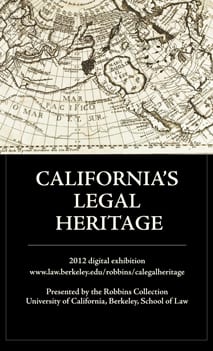2012 Digital Exhibition
University of California, Berkeley, School of Law
Follow the link below to access a print-friendly PDF version of the “California’s Legal Heritage” resource, complete with sources, glossary, photos, and bibliography.
On the eve of California’s statehood, numerous debates raged among the drafters of its constitution. One argument centered upon the proposed retention of civil law principles inherited from Spain and Mexico, which offered community property rights not conferred by the common law. Delegates for and against the incorporation of civil law elements into California’s common law future used dramatic, fiery language to make their cases, with parties on both sides taking opportunities to deride the “barbarous principles of the early ages.” Though invoked for drama, such statements were surprisingly accurate. The civil law tradition in question was one that in fact derived from the time when the Visigoths, one of the so-called “barbarian” tribes, invaded and won Spanish territory from a waning Roman Empire. This feat set in motion a trajectory that would take the Spanish law from Europe to all parts of Spanish America, eventually reaching its last settled territory, Alta California.
This migration of legal tradition happened over the course of more than a millennium. New and changing frontiers produced territorial, political and social demands that shaped legal culture and practice. The story begins in Iberia, a contested territory at the western edge of the Roman Empire that within three centuries would change from Roman to Visigothic to Muslim rule. The Christian kingdoms of medieval Spain emerged victorious from centuries of military contest with great complexity of legal traditions. As a result, Spanish monarchs from the great thirteenth-century legislator Alfonso the Wise to empire-builders Ferdinand and Isabel, endeavored to order and refine the multiplicity of legal codes to build royal authority and legislative unity.
The next great chapter in the story of California’s legal tradition was the exportation of Spanish law to the New World. After 1492, Spain found itself in control of a vast and complex territory. As Spanish-American institutions were created and the demands of colonial administration grew, there was a greater need than ever for order and clarity in the Castilian law, which carried over to Spain’s colonies, as well as a new need to create and systematize laws specific to the Indies.
As one of the last frontiers of Spanish settlement in America, California did not have a civilian population until nearly the end of the eighteenth century, over two hundred years after a vast system of royal courts had been established to administer justice from central Mexico to South America. When Spanish settlers did arrive in Alta California in the 1770s, they brought with them the civil law system that would govern the territory through Mexican independence from Spain to US statehood, bringing Spain’s ancient past to the farthest corner of this new society.
A video version of this exhibit is available for educational use below.